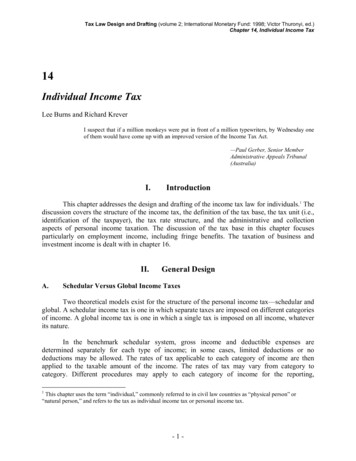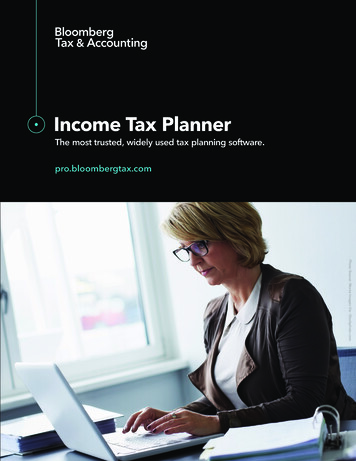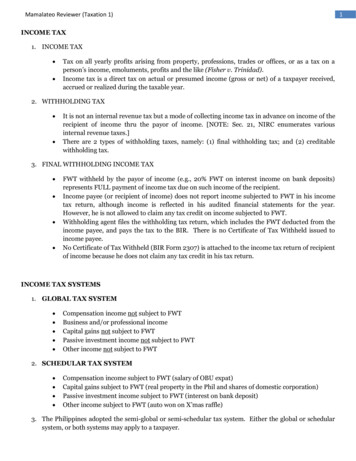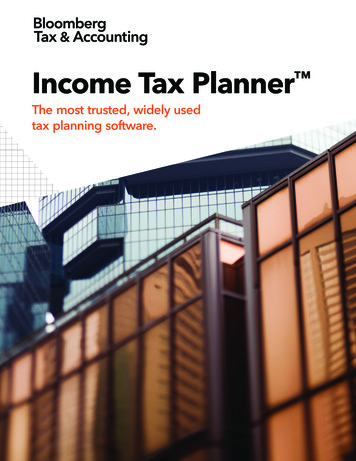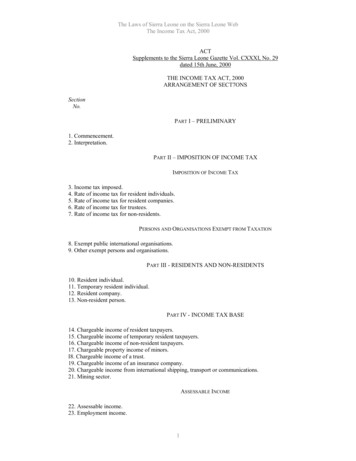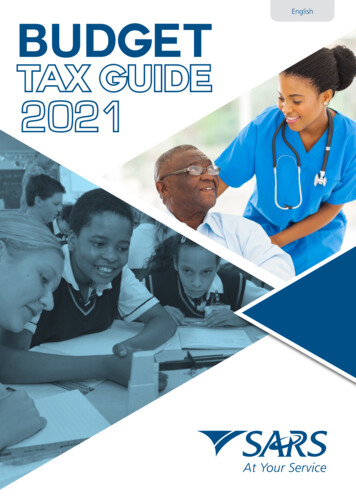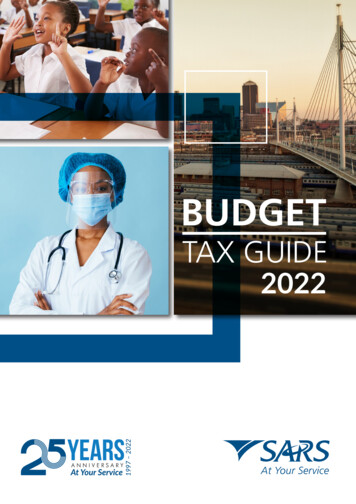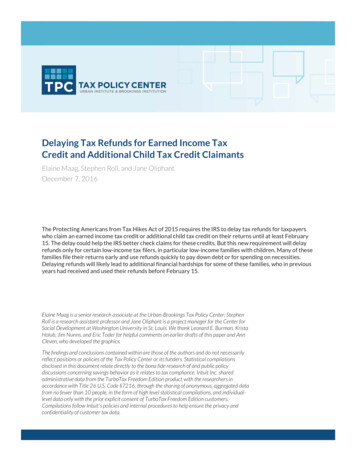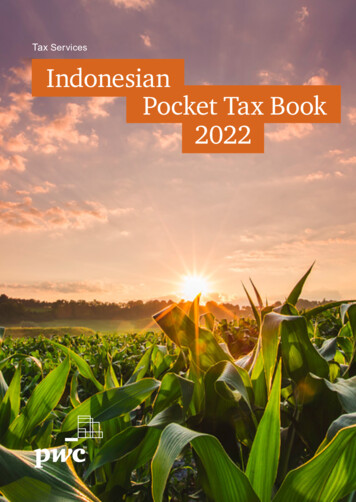
Transcription
IFRS for SMEs Standard (2015) Q&AsIFRS Foundation—Supporting Material for the IFRS for SMEs StandardModule 29—Income Tax
IFRS FoundationSupporting Materialfor the IFRS for SMEs Standardincluding the full text ofSection 29 Income Taxof the IFRS for SMEs Standardissued by the International Accounting Standards Board in October 2015with extensive explanations, self-assessment questions and case studiesIFRS FoundationColumbus Building7 Westferry CircusCanary WharfLondon E14 4HDUnited KingdomTelephone: 44 (0)20 7246 6410Email: info@ifrs.orgWeb: www.ifrs.orgPublications DepartmentTelephone: 44 (0)20 7332 2730Email: publications@ifrs.org
This module has been prepared by IFRS Foundation (Foundation) education staff. It has not been approved by the International AccountingStandards Board (Board). The module is designed to assist users of the IFRS for SMEs Standard (Standard) to implement and consistently applythe Standard.All rights, including copyright, in the content of this publication are owned by the IFRS Foundation.Copyright 2019 IFRS Foundation. All rights reserved.Email: info@ifrs.org Web: www.ifrs.orgDisclaimer: All implied warranties, including but not limited to the implied warranties of satisfactory quality, fitness for a particularpurpose, non-infringement and accuracy, are excluded to the extent that they may be excluded as a matter of law. To the extent permittedby applicable law, the Board and the Foundation expressly disclaim all liability howsoever arising whether in contract, tort or otherwise(including, but not limited to, liability for any negligent act or omissions) to any person in respect of any claims or losses of any nature,arising directly or indirectly from: (i) anything done or the consequences of anything done or omitted to be done wholly or partly inreliance upon the whole or any part of the contents of this publication; and (ii) the use of any data or materials contained in thispublication or otherwise. To the extent permitted by applicable law, the Board, the Foundation, the authors and the publishers shall not beliable for any loss or damage of any kind arising from use of and/or reliance on the contents of this publication or any translation thereof,including but not limited to direct, indirect, incidental or consequential loss, punitive damages, penalties or costs.Information contained in this publication does not constitute advice and should not be used as a basis for making decisions or treated as asubstitute for specific advice on a particular matter from a suitably qualified professional person. For relevant accounting requirements,reference must be made to the Standard issued by the Board.Any names of individuals, companies and/or places used in this publication are fictitious and any resemblance to real people, entities orplaces is purely coincidental.Right of use: Although the Foundation encourages you to use this module for educational purposes, you must do so in accordance with theterms of use below. If you intend to include our material in a commercial product, please contact us as you will need a separate licence. Fordetails on using our Standards, please visit www.ifrs.org/issued-standards.You must ensure you have the most current material available from our website. Your right to use this module will expire when this moduleis withdrawn or updated, at which time you must cease to use it and/or make it available. It is your sole responsibility to ensure you are usingrelevant material by checking the Foundation’s website for any amendments to the Standard, SME Implementation Group Q&As not yetincorporated and/or new versions of the modules.Terms of Use1)You can only reproduce the module in whole or in part in a printed or electronic stand-alone document provided that:(a) such document is supplied to participants free of charge;(b) you do not use or reproduce, or allow anyone else to use or reproduce, the Foundation logo that appears on or in the module;(c) you do not use or reproduce any trade mark that appears on or in the module if you are using all or part of the material toincorporate into your own documentation; and(d) you can only provide this module in whole through your website if you include a prominent link to our website (please see ourterms and conditions page for details on how to link your website to ours).2)The trade marks include those listed below.3)When you copy any extract from this publication for inclusion in another document you must ensure:(a) the documentation includes a copyright acknowledgement;(b)the documentation includes a statement that the Foundation is the author of the module and that the original module can beaccessed via the IFRS website www.ifrs.org;(c)the documentation includes in a prominent place an appropriate disclaimer, like that above;(d)the extract is shown accurately; and(e)the extract is not used in a misleading context.If you intend to provide any part of this module in print or electronically for any other purpose, please contact the Foundation as you willneed a written licence which may or may not be granted. For more information, please contact the licences ng).Please address publication and copyright matters to IFRS Foundation Publications Department:Email: publications@ifrs.org Web: www.ifrs.orgTrade mark noticeThe IFRS Foundation has trade marks registered around the world, including ‘eIFRS ’, ‘International Accounting Standards ’, ‘IAS ’, ‘IASB ’,the IASB logo, ‘IFRIC ’, ‘International Financial Reporting Standards ’, ‘IFRS ’, the IFRS logo, ‘IFRS Foundation ’, ‘IFRS for SMEs ’, theIFRS for SMEs logo, the ‘Hexagon Device’, ‘NIIF ’ and ‘SIC ’. Further details of the IFRS Foundation’s trade marks are available from theIFRS Foundation on request.
ContentsINTRODUCTIONWhich version of the IFRS for SMEs Standard?This moduleIFRS for SMEs StandardIntroduction to the requirementsWhat has changed since the 2009 IFRS for SMEs Standard111234REQUIREMENTS AND EXAMPLES 5Scope of this Section 5Recognition and measurement of current tax 12Recognition of deferred tax 21Measurement of deferred tax 65Measurement of both current and deferred tax 79Withholding tax on dividends 81Presentation 82Disclosures 86SIGNIFICANT ESTIMATES AND OTHER JUDGEMENTSScopeRecognition of deferred taxMeasurement92929295COMPARISON WITH FULL IFRS STANDARDS 96TEST YOUR KNOWLEDGE 97APPLY YOUR KNOWLEDGECase study 1Answer to case study 1Case study 2Answer to case study 2Case study 3Answer to case study 3IFRS Foundation: Supporting Material for the IFRS for SMEs Standard (version 2019-07)102102104110111113117
Module 29 – Income TaxThe accounting requirements applicable to small and medium-sized entities (SMEs)discussed in this module are set out in the IFRS for SMEs Standard, issued by theInternational Accounting Standards Board (Board) in October 2015.This module has been prepared by IFRS Foundation education staff.The contents of Section 29 Income Tax of the IFRS for SMEs Standard are set out in thismodule and shaded grey. The Glossary of terms of the IFRS for SMEs Standard(Glossary) is also part of the requirements. Terms defined in the Glossary are reproducedin bold type the first time they appear in the text of Section 29. The notes and examplesinserted by the education staff are not shaded. These notes and examples do not formpart of the IFRS for SMEs Standard and have not been approved by the Board.INTRODUCTIONWhich version of the IFRS for SMEs Standard?When the IFRS for SMEs Standard was first issued in July 2009, the Board said it wouldundertake an initial comprehensive review of the Standard to assess entities’ experience of thefirst two years of its application and to consider the need for any amendments. To this end, inJune 2012, the Board issued a Request for Information: Comprehensive Review of the IFRS for SMEs.An Exposure Draft proposing amendments to the IFRS for SMEs Standard was subsequentlypublished in 2013, and in May 2015 the Board issued 2015 Amendments to the IFRS for SMEsStandard.The document published in May 2015 only included amended text, but in October 2015, theBoard issued a fully revised edition of the Standard, which incorporated additional minoreditorial amendments as well as the substantive May 2015 revisions. This module is based onthat version.The IFRS for SMEs Standard issued in October 2015 is effective for annual periods beginning onor after 1 January 2017. Earlier application was permitted, but an entity that did so wasrequired to disclose the fact.Any reference in this module to the IFRS for SMEs Standard refers to the version issued inOctober 2015.This moduleThis module focuses on the accounting and reporting of income tax applying Section 29 IncomeTax of the IFRS for SMEs Standard. It introduces the subject and reproduces the official textalong with explanatory notes and examples designed to enhance understanding of therequirements. The module identifies the significant judgements required in accounting forincome tax. In addition, the module includes questions designed to test your understandingof the requirements and case studies that provides a practical opportunity to apply therequirements to account for income tax applying the IFRS for SMEs Standard.IFRS Foundation: Supporting Material for the IFRS for SMEs Standard (version 2019-07)1
Module 29 – Income TaxUpon successful completion of this module, you should, within the context of theIFRS for SMEs Standard, be able to: understand which taxes are income taxes; ascertain which tax rates and tax laws should be used in the measurement of currentand deferred tax assets and liabilities; recognise and measure current tax assets and liabilities; determine the tax base of assets, liabilities and other items that, although notrecognised as assets or liabilities, have a tax base; calculate temporary differences; identify unused tax losses and unused tax credits; determine which temporary differences, unused tax losses and unused tax creditsshould be recognised as deferred tax assets and liabilities; recognise and measure deferred tax assets and liabilities; allocate current and deferred tax to the related components of total comprehensiveincome (that is, continuing operations, discontinued operations or other comprehensiveincome) and equity; identify when current tax assets and current tax liabilities, and deferred tax assets anddeferred tax liabilities, can be offset; present and disclose income tax in financial statements; and demonstrate an understanding of significant estimates and other judgements requiredfor accounting for income tax.IFRS for SMEs StandardThe IFRS for SMEs Standard is intended to apply to the general purpose financial statementsof entities that do not have public accountability (see Section 1 Small and Medium-sizedEntities).The IFRS for SMEs Standard is comprised of mandatory requirements and othernon-mandatory material.The non-mandatory material includes: a preface, which provides a general introduction to the IFRS for SMEs Standard andexplains its purpose, structure and authority;implementation guidance, which includes illustrative financial statements and a tableof presentation and disclosure requirements;the Basis for Conclusions, which summarises the Board’s main considerations inreaching its conclusions in the IFRS for SMEs Standard issued in 2009 and, separately, inthe 2015 Amendments; andthe dissenting opinion of a Board member who did not agree with the issue of theIFRS for SMEs Standard in 2009 and the dissenting opinion of a Board member who didnot agree with the 2015 Amendments.In the IFRS for SMEs Standard, Appendix A: Effective date and transition, and Appendix B:Glossary of terms, are part of the mandatory requirements.IFRS Foundation: Supporting Material for the IFRS for SMEs Standard (version 2019-07)2
Module 29 – Income TaxIn the IFRS for SMEs Standard, there are appendices to Section 21 Provisions and Contingencies,Section 22 Liabilities and Equity and Section 23 Revenue. These appendices providenon-mandatory guidance.The IFRS for SMEs Standard has been issued in two parts: Part A contains the preface, all themandatory material and the appendices to Section 21, Section 22 and Section 23; and Part Bcontains the remainder of the material mentioned above.Further, the SME Implementation Group (SMEIG), which assists the Board with supportingimplementation of the IFRS for SMEs Standard, publishes implementation guidance as‘questions and answers’ (Q&As). These Q&As provide non-mandatory, timely guidance onspecific accounting questions raised with the SMEIG by entities implementing theIFRS for SMEs Standard and other interested parties. At the time of issue of this module(January 2019) the SMEIG has not issued any Q&As relevant to this module.Introduction to the requirementsThe objective of general purpose financial statements of a small or medium-sized entity is toprovide information about the entity’s financial position, performance and cash flows thatis useful for economic decision-making by a broad range of users who are not in a positionto demand reports tailored to meet their particular information needs. Such users include,for example, owners who are not involved in managing the business, existing and potentialcreditors and credit rating agencies.The objective of Section 29 is to prescribe the accounting requirements for income tax.Income tax includes all domestic and foreign taxes that are based on taxable profit. It alsoincludes taxes, such as withholding taxes, payable by a subsidiary, associate or joint ventureon distributions to the reporting entity.Current taxCurrent tax is the amount of income tax payable or recoverable in respect of the taxableprofit or loss for the current period or past reporting periods. An entity shall recognise acurrent tax liability for current tax payable. If the amount paid exceeds the amount due,the entity recognises a current tax asset.An entity measures current tax using the tax laws and rates that have been enacted orsubstantively enacted at the reporting date.Deferred taxDeferred tax assets and liabilities are recognised for income tax that is expected to berecoverable or payable in respect of the taxable profit for future reporting periods becauseof past transactions or events. Deferred tax arises from the difference between the amountsrecognised for the entity’s assets and liabilities in the statement of financial position andthe amounts recognised for those assets and liabilities by the tax authorities, as well as fromthe carryforward of currently unused tax losses and tax credits.Deferred tax assets and liabilities are measured using the tax rates and laws that areexpected to apply when the deferred tax asset is realised or the deferred tax liability issettled, and that have been enacted or substantively enacted at the end of the reportingperiod. Deferred tax assets are only recognised to the extent it is probable that taxableprofit will be available against which the deductible temporary differences, unused taxlosses and unused tax credits can be used.IFRS Foundation: Supporting Material for the IFRS for SMEs Standard (version 2019-07)3
Module 29 – Income TaxPresentation and disclosure of current and deferred taxCurrent and deferred tax expense is recognised in the same component of totalcomprehensive income (that is, continuing operations, discontinued operations or othercomprehensive income) or equity as the transaction or other event that resulted in the taxexpense.Current and deferred tax assets and liabilities are not discounted.Section 29 requires an entity to provide specified disclosures about current and deferred tax.What has changed since the 2009 IFRS for SMEs StandardWhen the 2009 version of the IFRS for SMEs Standard was issued, Section 29 was based on theIASB’s Exposure Draft Income Tax, published in March 2009, which proposed amendments toIAS 12 Income Tax. However, the changes proposed in the Exposure Draft were neverfinalised by the Board. Consequently, in the 2015 Amendments to the IFRS for SMEs, the Boardaligned the main requirements in Section 29 for recognising and measuring deferred taxwith the approach in IAS 12, modified to be consistent with the other requirements in theIFRS for SMEs Standard.The Board also introduced an undue cost or effort exemption to the requirement to offsetincome tax assets and liabilities (see paragraphs 29.37 and 29.41).Appendix A to the IFRS for SMEs Standard states that an entity may elect to apply the revisedSection 29 prospectively from the beginning of the first period in which it applies the 2015amendments. Where an entity applies the requirements prospectively it is required to statein the financial statements which amounts have not been restated.IFRS Foundation: Supporting Material for the IFRS for SMEs Standard (version 2019-07)4
Module 29 – Income TaxREQUIREMENTS AND EXAMPLESScope of this section29.1For the purpose of this Standard, income tax includes all domestic and foreign taxes thatare based on taxable profit. Income tax also includes taxes, such as withholding taxes,that are payable by a subsidiary, associate or joint venture on distributions to thereporting entity.NotesParagraph 29.1 defines income tax for the purposes of Section 29—income taxes aretaxes that are based on taxable profit. Taxable profit or tax loss is the profit or loss fora reporting period for which income taxes are payable or recoverable, determined inaccordance with rules established by the government taxation authority(ies). Taxableprofit equals taxable income less amounts deductible from taxable income. The taxrate, the percentage applied to the taxable profit to calculate the tax payable for theyear, is also governed by those rules.Section 29 applies only to income taxes. Taxable profit generally differs fromaccounting profit. Judging whether a tax is an ‘income tax’ sometimes requiresjudgement, based on the facts and circumstances.Taxes that are not based on taxable profits, and therefore do not constitute income taxfor the purposes of Section 29, include: sales taxes, because they are based on sales value (a gross amount) rather than ontaxable profits, for example, a tax based on the total value of sales of alcohol orcigarettes. consumption taxes levied on any value added to a product, such as value added tax(VAT), or goods and services tax (GST). production taxes that do not meet the definition of income tax because of thespecific terms, for example, a tax imposed on mining companies for each unitmined (tax based on an individual item). taxes payable on employee benefits paid, for example, social security taxes payablebased on a percentage of employees’ wages. Such taxes would be accounted forunder Section 28 Employee Benefits. stamp duty, a form of tax that is levied on documents based on the price paid.IFRS Foundation: Supporting Material for the IFRS for SMEs Standard (version 2019-07)5
Module 29 – Income TaxExample—scope of Section 29Ex 1Entity A pays tax to the authorities as follows: Corporate tax at the rate of 25% on profit before tax in the Statement ofComprehensive Income adjusted:oto deduct tax depreciation calculated in accordance with local legislation, inplace of accounting depreciation;oto exclude provisions for doubtful debts that are less than eight months old;andoto exclude all entertaining expenditures. Pollution tax paid to the tax authorities that varies with the quantity ofemissions in a year.The corporate tax is an income tax and Section 29 applies. The pollution tax is not atax based on taxable profit and so is not an income tax and—it is therefore outside thescope of Section 29.29.2This section covers accounting for income tax. It requires an entity to recognise thecurrent and future tax consequences of transactions and other events that have beenrecognised in the financial statements. These recognised tax amounts comprisecurrent tax and deferred tax. Current tax is income tax payable (recoverable) inrespect of the taxable profit (tax loss) for the current period or past periods. Deferredtax is income tax payable or recoverable in future periods, generally as a result of theentity recovering or settling its assets and liabilities for their current carryingamount, and the tax effect of the carryforward of currently unused tax losses and taxcredits.NotesSection 29 requires two calculations for income tax at the end of the reporting period: the calculation of the current tax expense (or income)—the amount of income taxpayable (or recoverable) in respect of the taxable profit (or tax loss) for the currentperiod and adjustments relating to current tax for prior periods. the calculation of the deferred tax expense (income)—the amount of income taxpayable (or recoverable) in respect of the taxable profit (or tax loss) for futureperiods as a result of past transactions or events.Accounting for income tax would be straightforward if accounting profit (that is, profitin the income statement or statement of comprehensive income) was always equal totaxable profit (that is, profit upon which income tax is payable) and both types of profitwere always determined using the same rules. In such a case, accounting for incometax would involve calculating the amount payable by applying the tax rate toaccounting profit, recognising a liability and an expense for the amount payable andrecording the eventual payment on settlement of the liability.However, the taxable profit for a period often differs, sometimes significantly, from theaccounting profit. This is because a jurisdiction’s tax laws may differ from theIFRS Foundation: Supporting Material for the IFRS for SMEs Standard (version 2019-07)6
Module 29 – Income TaxIFRS for SMEs Standard in terms of the recognition and measurement of income,expenses, assets and liabilities. For example, tax laws are sometimes influenced bypolitical objectives such as when tax deductions for certain capital expenditure arepermitted to encourage entities to invest in capital infrastructure. Consequently, thetax expense cannot be determined simply by multiplying accounting profit by the taxrate. Instead, accounting for income taxes involves calculating the tax payable for theyear (current tax) and also identifying and accounting for the tax payable orrecoverable in a future period as a result of past transactions (deferred tax).The two simple examples that follow illustrate the calculation of current tax anddeferred tax. In the two examples, the effect of accounting for deferred tax, inaddition to current tax, is that the tax effect of a transaction is reflected in the sameaccounting period (and same statement or part of statement, for example, profit or lossor other comprehensive income) as the transaction.The approach for deferred tax taken by Section 29 is to require an entity to comparethe carrying amount of its assets and liabilities recognised in the financial statementswith the effect that those assets and liabilities will have on the entity’s future taxpayments. If it is probable that recovery or settlement of that carrying amount willmake future tax payments larger or smaller than they would be if such recovery orsettlement were to have no tax consequences, then an entity recognises a deferred taxliability or a deferred tax asset.Assets and liabilities recognised in the statement of financial position must result froma past transaction. By using assets and liabilities as the starting point for calculatingdeferred tax, Section 29 ensures that deferred tax results only from past transactions.Example—deferred tax arising from interest incomeEx 2The only difference between an entity’s accounting profit and its taxable profitarises from the laws requiring interest income to be taxed when received in cash.Interest income is included in accounting profit when it is earned. The entity’saccounting profit was CU21,000 1 in 20X1 and CU20,000 in 20X2. The entity earnedinterest income of CU1,000 in 20X1, all of which was received, and so taxed, in20X2. No interest income was received in 20X1 and no interest income was earnedin 20X2. The entity incurs income tax at the rate of 30% of its taxable profit.The entity calculates current tax as follows:Accounting profitDeduct interest income not received in cashAdd interest income received in cashTaxable 41,000In this example, and in all other examples in this module, non-foreign currency monetary amounts are denominated incurrency units (CU).IFRS Foundation: Supporting Material for the IFRS for SMEs Standard (version 2019-07)7
Module 29 – Income TaxCurrent tax expense30% taxable profit6,3006,00012,300The entity calculates deferred tax as follows:20X220X1CUCUCarrying amount: interest receivable–1,000Tax base (ie future taxdeductions)––Temporary difference–1,00030% temporarydifference–300change in the deferred taxliability for the period(300)300CalculationDeferred tax liabilityDeferred tax expense/(income)The entity’s income tax expense would be presented in its statement of comprehensiveincome or income statement or statement of income and retained earnings as follows:20X220X1ExplanationCUCUaccounting profit20,00021,000current tax deferred tax(6,000)(6,300)14,00014,70030%30% Profit before taxIncome tax expenseProfit for the yearEffective rate of taxIncome tax expense Profit before taxNotes:The temporary difference in this example arises from a difference in the timing ofincome recognition for accounting and tax purposes —the interest income isrecognised in profit or loss in one period (CU1,000 in 20X1) but, under the tax laws, isincluded in taxable income (profit) in a different period (CU1,000 in 20X2). The totalamount included in accounting profit (CU1,000) and taxable profit is the same over thetwo-year period.By recognising a deferred tax liability in respect of the temporary difference in 20X1and the reversal of that liability in 20X2, the entity’s total tax expense (current taxexpense deferred tax expense) equals 30% accounting profit in each of the twoyears.IFRS Foundation: Supporting Material for the IFRS for SMEs Standard (version 2019-07)8
Module 29 – Income TaxExample—deferred tax arising because of accelerated tax depreciationEx 3The only difference between an entity’s accounting profit and its taxable profitarises from the laws permitting the cost of a particular type of machine with auseful life of three years to be fully deductible for tax purposes in the year ofpurchase. For financial reporting purposes, the entity depreciates the machine ona straight-line basis over three years to a nil residual value. The entity acquired themachine for CU600 on 1 January 20X1. Its accounting profit is CU1,000 for each ofthe years 20X1–20X3. The entity incurs income tax at the rate of 30% of its taxableprofit.The entity calculates current tax as follows:CalculationAccounting profitAdd back accountingdepreciationCU600 3 yearsDeduct tax depreciationTaxable profitCurrent tax expense30% taxable 1,2006003,000360360180900The entity calculates deferred tax on the machine as follows:Carrying amountTax base (ie future taxdeductions)20X320X220X1CalculationCUCUCUCU600 less CU200depreciation per year–200400nil as CU600 all deductedin 20X1––––20040030% temporarydifference–60120change in the deferred taxliability for the period(60)(60)120Temporary differenceDeferred tax liabilityDeferred tax expense/(income)IFRS Foundation: Supporting Material for the IFRS for SMEs Standard (version 2019-07)9
Module 29 – Income TaxThe entity’s income tax expense, for inclusion in its statement of comprehensiveincome or income statement or statement of income and retained earnings, iscalculated as follows:20X320X220X1CUCUCUCurrent income tax360360180Deferred income tax(60)(60)120Current tax deferred tax300300300The entity’s income tax expense would be presented as follows:20X320X220X1CalculationCUCUCUaccounting profit1,0001,0001,000current tax deferred tax(300)(300)(300)700700700 Profit before taxIncome tax expenseProfit for the yearNotes:The temporary difference (accelerated tax allowance) in this example arises from adifference in the timing of the expense recognition for accounting and tax purposes.The expenses recognised in profit or loss in one period (CU200 per year in 20X1–20X3)are, under the tax laws, included in taxable income (profit) in a different period (CU600in 20X1). The total amount included in accounting profit (CU600) and taxable profit isthe same over the three-year period.By recognising a deferred tax liability in respect of the temporary difference, theentity’s tax expense reflects the temporary nature of the accelerated tax allowance.Accordingly, in this simple example total tax expense (current tax expense deferredtax expense) equals 30 % CU1,000 accounting profit in each year from 20X1 to 20X3.Summary of overall approach for income taxA summary of the overall approach for accounting for income tax is as follows:(i)determine which taxes are income taxes for the purposes of theIFRS for SMEs Standard (paragraphs 29.1–29.3 and 29.34);(ii)recognise, in the statement of financial position, current tax measured using thetax rates and
IFRS Foundation: Supporting Material for the IFRS for SMEs Standard (version 2019-07) 1 The accounting requirements applicable to small and medium-sized entities (SMEs) discussed in this module are set out in the IFRS for SMEs Standard, issued by the International Accounting Standards Board (Board) in October 2015.


